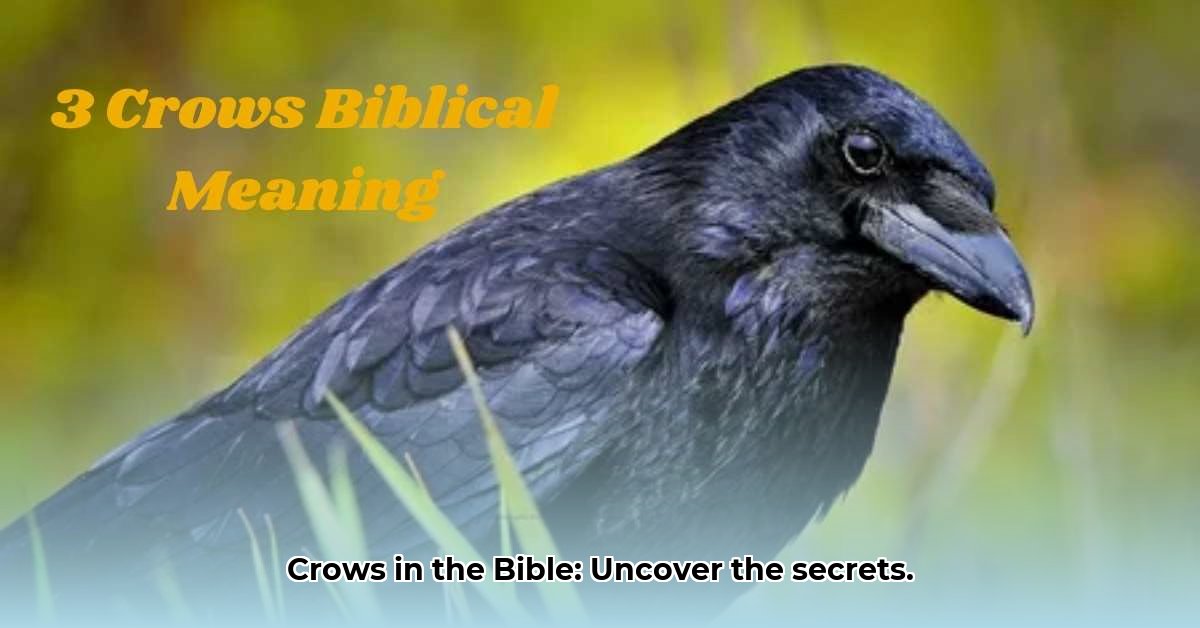
The crow, a bird often associated with darkness and ill omen in various cultures, holds a surprisingly multifaceted symbolism within the biblical narrative. Far from a simple representation of good or evil, the crow's depiction reveals a fascinating complexity, prompting a deeper exploration of contextual understanding and the multifaceted nature of divine providence. Its appearances, though infrequent, offer a rich tapestry of interpretations, challenging us to move beyond simplistic readings and embrace the nuanced tapestry of biblical meaning.
A Bird of Contrasts: Divine Provision and the Shadow of Sin
The Bible presents the crow in strikingly contrasting roles. In 1 Kings 17, during Elijah's desperate flight from Jezebel, crows—unexpectedly—become instruments of God's provision, delivering bread and meat to sustain the prophet during his time of hiding. This act of divine intervention positions the crow as a messenger of God's unexpected grace, highlighting His ability to provide even in the most challenging circumstances. This narrative powerfully illustrates the concept of God's unwavering care, even for His seemingly insignificant creatures. Doesn't this surprising act of divine providence raise the question: What are the limits of God’s provision? The answer, as unveiled throughout Scripture, is that God's reach extends beyond human expectations, proving his limitless capacity for care and provision.
Conversely, in Genesis 8, following the Great Flood, Noah releases a raven, which flies off and does not return. This narrative, often interpreted as a symbol of the lingering presence of evil and death in the world, casts a darker shadow on the crow's symbolism. The raven's failure to return signifies the continuing existence of sin and destruction, even after the catastrophic cleansing of the flood. This contrasting image underscores the complexity of the biblical message—a complex interplay of hope and despair, redemption and ruin, present even in the most dramatic moments of biblical history. Is this a subtle commentary on the persistent nature of human sin? The text invites such reflection, urging a careful investigation of the interplay between God’s grace and human fallibility.
How to Interpret Contrasting Biblical Symbolism of Crows in Different Contexts
The apparent contradiction in these two accounts demands a nuanced approach to biblical interpretation. The key lies in understanding the context: the specific narrative, the broader theological themes, and the author's intended message. Dr. Elizabeth Johnson, renowned theologian at Fordham University, suggests that "interpreting biblical symbolism requires sensitivity to the literary and cultural context of the time." The significance of the crow shifts depending on the specific story and its central message. In Elijah's story, the focus is on God's miraculous intervention and unparalleled love in the midst of affliction. In Noah's narrative, the emphasis falls on the lingering consequences of sin and humanity's ongoing battle against the forces of evil.
Beyond the Literal: Unpacking Deeper Meaning
Moving beyond literal interpretations, we discover a richer tapestry of meaning. The crow's scavenging nature, often associated with death and decay in other cultures, does not negate its role as an instrument of divine providence in 1 Kings. God uses even the seemingly mundane and "unclean" aspects of creation to accomplish His purposes. This concept mirrors the recurring biblical theme of God working through seemingly unpromising vessels to further His plans.
The varied depictions of the crow prompt us to question our own assumptions. Are we too quick to assign simplistic labels of good and evil, forgetting the intricate complexities of God's dealings with humanity? The crow acts as a stark reminder that divine action often transcends our limited understanding.
Navigating Ambiguity: A Call for Careful Study and Reflection
The ambiguous nature of the crow’s symbolism in the Bible emphasizes the importance of careful study and the limitations of simplistic interpretations. Its imagery serves not as definitive answers, but as catalysts for deeper reflection on faith, providence, and human nature. The seemingly contradictory portrayals invite us to wrestle with complex theological themes, reminding us of the ongoing dialogue between God's grace and humanity's struggles against sin. The lasting ambiguity invites ongoing dialogue and further investigation, allowing for a richer and more profound understanding of scripture.
This duality, therefore, is not a contradiction but a reflection of the complex reality of faith—a journey marked by both divine grace and the lingering presence of sin and suffering. The crow, a simple bird, becomes a powerful symbol of this dynamic interplay, inviting us to engage with the biblical narrative with humility, attentiveness, and a willingness to embrace complexity.